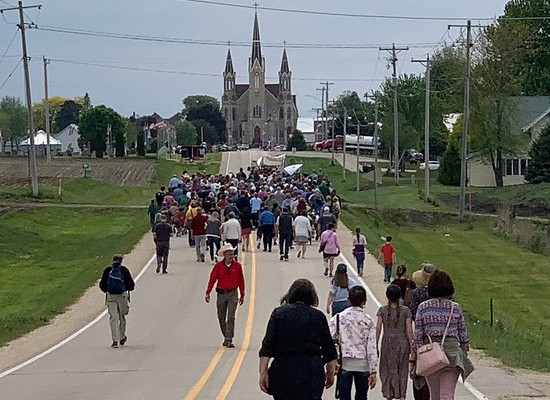
Catholics are encouraged to turn out in strong numbers for the National Eucharistic Pilgrimage’s Eucharistic processions to counter the growing number of anti-Catholic protesters who have afflicted the route’s public events from the first week.
“We need to be there. We need to show up for Jesus,” said Jason Shanks, president of National Eucharistic Congress Inc. “This is the Way-of-the-Cross type of pilgrimage. This is walking with our Lord against attacks.”
With megaphones and speakers, the protesters have been preaching against Catholic beliefs, including that Jesus is truly and fully present in the Eucharist. A few protesters have been present at public events since the end of the pilgrimage’s first week in late May, but an estimated 40 to 50 protesters, including families with children, met the pilgrimage at May 30-June 2 events in Oklahoma.
Protesters include members of the Church of Wells in Wells, Texas, a town in the northeast part of the state. A church elder told OSV News that the group aims “to put the ‘protest’ back into ‘Protestant Christianity.'”
“We hope that through preaching many people will come to understand the vast difference between Catholicism and Protestantism,” Sean Michael Morris, a Church of Wells elder, said in a June 2 email to OSV News.
However, he said, “We do not wish to be associated with any particular church. There have been Protestant believers attending the processions for the same purpose who are not a part of any church in Texas.”
National Eucharistic Pilgrimage organizers expect the protests to grow as the 36-day pilgrimage enters Texas and the Diocese of Dallas June 3, and to continue until the pilgrimage culminates in Los Angeles for the feast of Corpus Christi June 22.
The pilgrimage’s 2025 St. Katharine Drexel Route covers 3,340 miles over 10 states in 20 dioceses. Its eight perpetual pilgrims — young adults who are traveling the full distance — began in Indianapolis May 18 and have so far stopped at parishes, shrines and other Catholic sites in Illinois, Iowa, Missouri, Kansas and Oklahoma. After stops in Texas June 3-11, they will cross New Mexico, Arizona and Southern California.
The pilgrims’ stops include Mass, Eucharistic adoration and charitable service, and also public processions, which is where they have encountered the majority of the protesters.
Last year’s inaugural National Eucharistic Pilgrimage — an eight-week, four-route endeavor that culminated in Indianapolis ahead of the 10th National Eucharistic Congress in July 2024 — did not encounter similar protests, Shanks said.
He encouraged Catholics who attend the 2025 pilgrimage’s processions to show charity and humility, and he discouraged them from interacting with the protesters. He said that Catholics should be aware that efforts to debate or challenge the protesters may appear on social media.
“We don’t need to engage with these folks,” he said. “We need to keep our eyes focused on the Lord in prayer and adoration. We need to be courageous and steadfast.”
Catholics should also be prepared to hear insults against the faith, he advised.
But attending the pilgrimage’s processions — especially as part of a large crowd — is a way for Catholics to demonstrate their faith, he said. “We as Catholics have been talking about how do we evangelize and catechize — and getting out there, this is our public witness,” he said.
Shanks said that the National Eucharistic Congress Inc. is addressing potential security factors but that the protesters have not yet caused the pilgrimage to alter its public schedule. However, he encouraged people planning to attend the pilgrimage’s events to register, so that pilgrimage organizers can directly communicate any schedule changes.
Shanks also asked for prayers for the perpetual pilgrims and any spiritual battles they might encounter. He said that the pilgrims are being cared for by their chaplains from the Franciscan Friars of the Renewal and their team leader, that the NEC’s leaders are also checking in with them regularly, and that there are mental health professionals ready to assist if needed.
“This is going right at their interior life,” he said. Drawing a parallel to Jesus’ journey on the Via Dolorosa, the route he took while carrying the cross in Jerusalem to his crucifixion and death, Shanks said, “They’re (walking) the Way of the Cross.”
“Pilgrimage is suffering, and they’re suffering for our Lord,” he said. “They’re walking with Jesus. They’re hearing this. And it’s not just one time. … It’s traveling with them.”
Maria Wiering is senior writer for OSV News.




